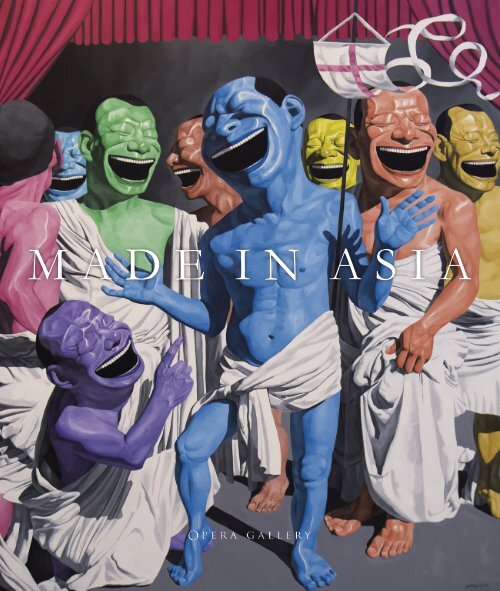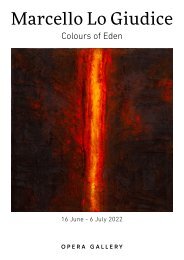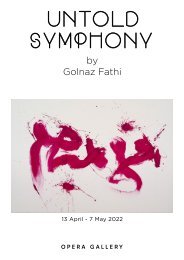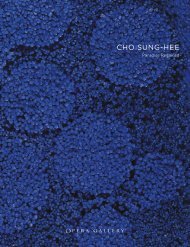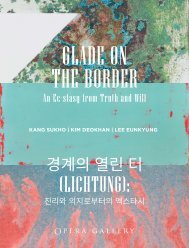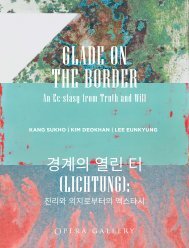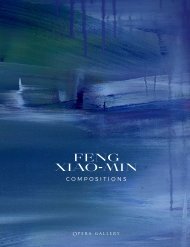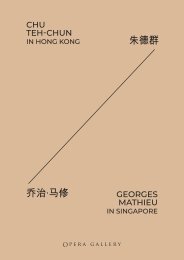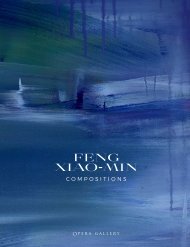Made in Asia Catalogue
You also want an ePaper? Increase the reach of your titles
YUMPU automatically turns print PDFs into web optimized ePapers that Google loves.
m a d e i n a s i a
m a d e i n a s i a<br />
14-27 March 2018
PREFACE<br />
“We want to see the newest th<strong>in</strong>gs. That is because we want to see the future, even if only momentarily. It is the moment<br />
<strong>in</strong> which, even if we don't completely understand what we have glimpsed, we are nonetheless touched by it."<br />
Takashi Murakami<br />
<strong>Made</strong> <strong>in</strong> <strong>Asia</strong>, is a curated collection of works dedicated entirely to, or <strong>in</strong>spired by <strong>Asia</strong>. We are excited to<br />
be hold<strong>in</strong>g this exhibition <strong>in</strong> co-ord<strong>in</strong>ation with <strong>Asia</strong> Week, March 14-27.<br />
Carry<strong>in</strong>g forward our mission to promote and advance <strong>Asia</strong>n art <strong>in</strong> New York City, <strong>Made</strong> <strong>in</strong> <strong>Asia</strong> will add to<br />
the important and excit<strong>in</strong>g cross-cultural dialogue between East and West.<br />
<strong>Made</strong> <strong>in</strong> <strong>Asia</strong> features many high-profile artists and works <strong>in</strong>clud<strong>in</strong>g excit<strong>in</strong>g pieces by Japanese ‘Pop’ artists<br />
Takashi Murakami and Yoshitomo Nara alongside Ch<strong>in</strong>ese socio-political pa<strong>in</strong>ters Yue M<strong>in</strong>jun, Wang<br />
Guangyi and Zhang Xiaogang, a "video robot" sculpture by Korean Paik Nam June will rub shoulders with<br />
Andy Warhol’s notorious Chairman ‘Mao’ and delicate, expressive works by Yan Pei M<strong>in</strong>g and Zhang Huan<br />
will contrast with the heavy yet <strong>in</strong>tricate sculptures of Seo Young-Deok. The exhibition will also showcase a<br />
number of sublime, saturated, mixed media artworks by Zhuang Hong Yi, his abstracted sculptural pa<strong>in</strong>t<strong>in</strong>gs,<br />
<strong>in</strong>corporat<strong>in</strong>g oriental rice paper, offer visitors an immersive experience, a moment of transcendental calm<br />
with<strong>in</strong> the eclectic energy of this frenetic city.<br />
<strong>Made</strong> <strong>in</strong> <strong>Asia</strong> is an exhibition that embodies the spirit of Opera Gallery, our determ<strong>in</strong>ation to bridge cultural<br />
and aesthetic gaps through accessibility and excellence for the benefit of new and established art collectors.<br />
We are delighted to be able to br<strong>in</strong>g these works together <strong>in</strong> celebration.<br />
Amos Frajnd | Director of Opera Gallery New York<br />
Gilles Dyan | Chairman and Founder of Opera Gallery Group<br />
3
CHINA
Yue M<strong>in</strong>jun (b. 1962)<br />
In his oil pa<strong>in</strong>t<strong>in</strong>gs, Yue M<strong>in</strong>jun often <strong>in</strong>serts himself <strong>in</strong> iconic moments <strong>in</strong> art history, pa<strong>in</strong>t<strong>in</strong>g<br />
exaggerated self-portrait figures <strong>in</strong> candy colors. The figures bear wide smiles with gap<strong>in</strong>g mouths as<br />
they enact poses from the works of Caravaggio and other artists from the Western canon. Transform<strong>in</strong>g<br />
himself <strong>in</strong>to an icon, the artist has said, “it was not meant as a self-portrait <strong>in</strong> its traditional sense,<br />
but someth<strong>in</strong>g more like a movie star act<strong>in</strong>g <strong>in</strong> different roles.” Surrealism was an early <strong>in</strong>fluence on<br />
Yue, who shot to the top of an explosive Ch<strong>in</strong>ese contemporary scene as a member of the Cynical<br />
Realist movement, his serious political criticism and social commentary hidden beh<strong>in</strong>d the mask of<br />
his smil<strong>in</strong>g faces. In another series, Yue turned his practice on its head, recreat<strong>in</strong>g famous Western<br />
and Ch<strong>in</strong>ese socialist pa<strong>in</strong>t<strong>in</strong>gs as empty sett<strong>in</strong>gs with their subjects removed.<br />
The Resurrection, 2010<br />
Oil on canvas . 153.5 x 130 <strong>in</strong> | 390 x 330 cm<br />
Provenence<br />
Pace Gallery, Beij<strong>in</strong>g<br />
Private collection, Geneva<br />
6
7
8
Everywhere, 2002<br />
Oil on canvas . 41.3 x 54.7 <strong>in</strong> | 105 x 139 cm<br />
Provenence<br />
Private collection, <strong>Asia</strong><br />
9
Zhang Xiaogang (b. 1958)<br />
Zhang Xiaogang is a Ch<strong>in</strong>ese artist, he was born <strong>in</strong> Kunm<strong>in</strong>g, Ch<strong>in</strong>a <strong>in</strong> 1958. He is currently based<br />
<strong>in</strong> Beij<strong>in</strong>g. Rely<strong>in</strong>g on memory to recreate a highly personal version of his country’s history, Zhang<br />
Xiaogang makes art that is as much about himself as it is about Ch<strong>in</strong>a’s past. The grim imag<strong>in</strong>ary<br />
families <strong>in</strong> his Bloodl<strong>in</strong>es: The Big Family pa<strong>in</strong>t<strong>in</strong>gs of the 1990s and his 2005–06 series of grisaille<br />
portraits <strong>in</strong> oil reveal countless narratives about the aspirations and failures of the Cultural Revolution<br />
as well as Zhang’s own emotions. Like the blank visages of the <strong>in</strong>dividuals <strong>in</strong> these pa<strong>in</strong>t<strong>in</strong>gs, Zhang’s<br />
brass and concrete sculptures of figures, as well as implements used for record<strong>in</strong>g history (such as<br />
founta<strong>in</strong> pens, notebooks, and light bulbs, all 2009), appear compressed and distorted by memory,<br />
age, and some unknown force.<br />
Red Baby, 2009<br />
Oil on canvas . 78.7 x 102.4 <strong>in</strong> | 200 x 260 cm<br />
10
11
Wang Guangyi (b. 1957)<br />
Wang Guangyi is a Ch<strong>in</strong>ese artist. He was born <strong>in</strong> Heilongjiang, Ch<strong>in</strong>a <strong>in</strong> 1957 and is currently based <strong>in</strong><br />
Beij<strong>in</strong>g. Wang Guangyi repurposes historical Ch<strong>in</strong>ese propaganda images <strong>in</strong>to pa<strong>in</strong>t<strong>in</strong>gs that poke fun<br />
at the <strong>in</strong>tersection of Ch<strong>in</strong>a’s communist history and the rise of Western <strong>in</strong>fluence. Associated with<br />
Political Pop, Wang is best known for his Great Criticism series (1998), which <strong>in</strong>cludes works like Great<br />
Criticism - Louis Vuitton and Great Criticism - Coca-Cola, where he juxtaposes red and yellow Mao-era<br />
posters with branded symbols, <strong>in</strong>vented serial numbers, and Wang’s own captions (“No!”). An early<br />
affiliate of Ch<strong>in</strong>a’s 85 New Wave Movement, Wang helped usher <strong>in</strong> the era of contemporary Ch<strong>in</strong>ese art<br />
and was among the first Ch<strong>in</strong>ese artists to co-opt Mao Zedong iconography <strong>in</strong> his practice.<br />
Great Criticism: Coca-Cola, 2005<br />
Oil on canvas . 59.1 x 47.2 <strong>in</strong> | 150 x 120 cm<br />
12
13
Zhang Huan (b. 1965)<br />
Zhang Huan is a Ch<strong>in</strong>ese artist born <strong>in</strong> Anyang prov<strong>in</strong>ce, Ch<strong>in</strong>a <strong>in</strong> 1965. He is currently based <strong>in</strong><br />
Shanghai. One of Ch<strong>in</strong>a's best-known performance and conceptual artists, Zhang Huan's more recent<br />
work has consisted of sculptures and pa<strong>in</strong>t<strong>in</strong>gs that reference the history of his native Ch<strong>in</strong>a, from<br />
significant political, <strong>in</strong>tellectual and religious figures to anonymous portraits and landscape scenes.<br />
For his two- and three-dimensional works, Zhang frequently uses both common objects and unusual<br />
organic materials, <strong>in</strong>clud<strong>in</strong>g feathers, cowhides, and for his 2005 sculpture Donkey, a taxidermy<br />
donkey. Particularly evocative is Zhang’s use of <strong>in</strong>cense ash, a material that epitomizes both detritus<br />
and religious ritual, with which he pa<strong>in</strong>ts and sculpts works that are as olfactory as they are visual.<br />
Li Q<strong>in</strong>g, 2007<br />
Incense ashes and adhesive on canvas . 59.1 x 39.4 <strong>in</strong> | 150 x 100 cm<br />
14
15
Qi Zhilong (b. 1962)<br />
Qi Zhilong, one of the lead<strong>in</strong>g figures of Gaudy Art <strong>in</strong> Ch<strong>in</strong>a, was born <strong>in</strong> Hohhot, Inner<br />
Mongolia, Ch<strong>in</strong>a. In 1992, four years after he graduated from the Central Academy of F<strong>in</strong>e<br />
Arts, Qi moved <strong>in</strong>to the Summer Palace Artist Village <strong>in</strong> Beij<strong>in</strong>g, where Political Pop and<br />
Cynical Realism just started ga<strong>in</strong><strong>in</strong>g popularity. With the <strong>in</strong>tention to revolt aga<strong>in</strong>st the Political<br />
Pop movement, Qi started his consumer icons series, us<strong>in</strong>g oil and pa<strong>in</strong>t to commercialize<br />
the idealistic icons created by Political Pop, as well as the icons that it was try<strong>in</strong>g to confront.<br />
Ch<strong>in</strong>ese Girl, 2002<br />
Oil on canvas . 63.8 x 51.2 <strong>in</strong> | 162 x 130 cm<br />
16
17
Yan Pei M<strong>in</strong>g (b. 1960)<br />
Yan Pei M<strong>in</strong>g is a Ch<strong>in</strong>ese artist. He was born <strong>in</strong> Shanghai, Ch<strong>in</strong>a <strong>in</strong> 1960. Fus<strong>in</strong>g the Western<br />
tradition of portrait pa<strong>in</strong>t<strong>in</strong>g with Ch<strong>in</strong>a’s cultural history, Yan Pei M<strong>in</strong>g creates large-scale works<br />
depict<strong>in</strong>g real and imag<strong>in</strong>ary people. Yan’s portraits, typically mono- or bi-chromatic, often verge on<br />
abstraction, with broad, patterned brushstrokes and drips of pa<strong>in</strong>t. He is perhaps best known for<br />
his monumental self-portraits, <strong>in</strong>clud<strong>in</strong>g Double (Selfportrait at the Morgue) (2006), a watercolor of the<br />
artist as a dead man, as well as his eight-foot-tall portraits of Mao Zedong, Bruce Lee and his father.<br />
Tête no. 5, 2003<br />
Charcoal on paper . 78.7 x 49.2 <strong>in</strong> | 200 x 125 cm<br />
18
19
Li Shan (b. 1942)<br />
Li Shan is a pa<strong>in</strong>ter and prom<strong>in</strong>ent figure <strong>in</strong> the Political Pop movement that developed <strong>in</strong> Ch<strong>in</strong>a <strong>in</strong><br />
the 1990s. He is best known for his portraits of Mao Zedong set aga<strong>in</strong>st a background of blue, p<strong>in</strong>k,<br />
or green color and often accompanied by a lotus flower. Born <strong>in</strong> Heilongjiang prov<strong>in</strong>ce, Li studied<br />
oil pa<strong>in</strong>t<strong>in</strong>g at the Shanghai Drama Institute before establish<strong>in</strong>g his place on the Shanghai art scene.<br />
Beg<strong>in</strong>n<strong>in</strong>g <strong>in</strong> the late 1970s, Li rejected Socialist Realism, a style popular among his contemporaries,<br />
and dist<strong>in</strong>guished his own work as self-expressive and politically critical. His most famous series of<br />
pa<strong>in</strong>t<strong>in</strong>gs, entitled Rouge and started <strong>in</strong> the late 1980s, depicts stylized figures, abstract flowers, and<br />
portraits of Mao rem<strong>in</strong>iscent of Andy Warhol’s screenpr<strong>in</strong>ts of the same subject.<br />
Untitled, 2006<br />
Acrylic and collage on canvas . 21.3 x 17.7 <strong>in</strong> | 54 x 45 cm<br />
20
21
Li Tianb<strong>in</strong>g (b. 1974)<br />
Li Tianb<strong>in</strong>g is a Ch<strong>in</strong>ese artist born <strong>in</strong> Guil<strong>in</strong>, Ch<strong>in</strong>a <strong>in</strong> 1974. When he was 12 years old, he sold<br />
a cow and used the proceeds to purchase his first camera, with which he has been travers<strong>in</strong>g the<br />
mounta<strong>in</strong>s <strong>in</strong> Fujian prov<strong>in</strong>ce ever s<strong>in</strong>ce, tak<strong>in</strong>g portraits of the people who live <strong>in</strong> the impoverished,<br />
rural villages. Entirely self-taught, he uses black-and-white film, sometimes add<strong>in</strong>g touches of color<br />
by hand. Rather than nam<strong>in</strong>g the <strong>in</strong>dividuals <strong>in</strong> his portraits, Li labels each one “Comrade”, adher<strong>in</strong>g<br />
to the Communist form of address. Through his decades of work, he has amassed a straightforward,<br />
subtle, and sensitive visual record of multiple generations of people, who have lived through<br />
momentous transitions <strong>in</strong> Ch<strong>in</strong>a’s history, <strong>in</strong>clud<strong>in</strong>g <strong>in</strong>dependence from colonial rule, the Cultural<br />
Revolution, and rapid modernization.<br />
Moi et mon frère avec Deng Xiaop<strong>in</strong>g, 2011<br />
Oil on canvas . 63 x 80.7 <strong>in</strong> | 160 x 205 cm<br />
22
23
24
Sitt<strong>in</strong>g before the Propaganda, 2011<br />
Oil on canvas . 96.1 x 70.9 <strong>in</strong> | 180 x 244 cm<br />
25
Kong L<strong>in</strong>gnan (b. 1983)<br />
Kong L<strong>in</strong>gnan is a Ch<strong>in</strong>ese artist born <strong>in</strong> 1983. She is known for her beautiful scenes constructed<br />
from glow<strong>in</strong>g neon l<strong>in</strong>es. Born <strong>in</strong> Jil<strong>in</strong> prov<strong>in</strong>ce, the artist graduated from the Central Academy of<br />
F<strong>in</strong>e Arts, and is currently based <strong>in</strong> Beij<strong>in</strong>g.<br />
Odyssey 5, 2013<br />
Oil on canvas . 35.4 x 47.2 <strong>in</strong> | 90 x 120 cm<br />
26
27
28
Odyssey 23, 2013<br />
Oil on canvas . 35.4 x 47.2 <strong>in</strong> | 90 x 120 cm<br />
29
Liu Dao<br />
Island6, or Liu Dao, is a Shanghai-based electronic and <strong>in</strong>teractive art group where artists and<br />
technologists actively engage with culture, address<strong>in</strong>g the issues and concerns of our time. The group<br />
challenges convention, encourages collaboration and celebrates the most cutt<strong>in</strong>g edge technology<br />
available. While explor<strong>in</strong>g the cultural potential <strong>in</strong> the convergence of art, technology and science,<br />
and the collective's discoveries are applied toward the benefit of the artist community. Interaction is<br />
generated <strong>in</strong> the environment but also with<strong>in</strong> the art pieces. The use of technology such as sensors,<br />
motion-track<strong>in</strong>g devices, GPRS modem controlled videos, sonar rangef<strong>in</strong>ders or \"Ardu<strong>in</strong>o\"<br />
microcontrollers are utilized to create <strong>in</strong>teractive pieces that challenge current digital <strong>in</strong>terfaces and<br />
<strong>in</strong>teractivity solutions and develop new forms of expression through new media technologies. Liu<br />
Dao produces <strong>in</strong>teractive <strong>in</strong>stallations, electronic art, performance and multimedia shows <strong>in</strong> Shanghai.<br />
Speak on about the Spokes, 2015<br />
LED display, acrylic pa<strong>in</strong>t<strong>in</strong>g, paper collage . 35.4 x 35.4 x 2 <strong>in</strong> |<br />
90 x 90 x 5 cm<br />
30
31
Zhuang Hong Yi (b. 1962)<br />
Zhuang Hong Yi is a Ch<strong>in</strong>ese artist. He was born <strong>in</strong> Sichuan, Ch<strong>in</strong>a, <strong>in</strong> 1962. Zhuang now travels<br />
constantly between East and West, work<strong>in</strong>g alternately between his studio <strong>in</strong> Rotterdam, The<br />
Netherlands and his Beij<strong>in</strong>g studio. As such, his work references Western artistic movements,<br />
specifically Impressionism comb<strong>in</strong>ed with Eastern <strong>in</strong>spired techniques <strong>in</strong>corporat<strong>in</strong>g the use of<br />
rice paper. Known for his “color-chang<strong>in</strong>g” sculptural pa<strong>in</strong>t<strong>in</strong>gs, Zhuang Hong Yi has mastered a<br />
three-dimensional technique, which draws <strong>in</strong>spiration from the life affirm<strong>in</strong>g glory of nature,<br />
specifically the dynamic saturated colors rem<strong>in</strong>iscent of the ubiquitous tulip fields of Holland. Zhuang<br />
has achieved <strong>in</strong>ternational acclaim for his bold idiosyncratic pa<strong>in</strong>t<strong>in</strong>gs which have featured <strong>in</strong> over 30<br />
solo exhibitions and important group shows <strong>in</strong> major venues worldwide <strong>in</strong>clud<strong>in</strong>g the Found Museum<br />
<strong>in</strong> Beij<strong>in</strong>g, Ch<strong>in</strong>a, the Gron<strong>in</strong>ger Museum <strong>in</strong> The Netherlands and <strong>in</strong> Venice, Italy <strong>in</strong> conjunction with<br />
the 55 th Venice Biennale of 2013.<br />
Left view detail<br />
Right view detail<br />
17-I-035, 2017<br />
Collage of rice paper, acrylic, <strong>in</strong>k and varnish on canvas . 35.4 x 35.4 <strong>in</strong> | 90 x 90 cm<br />
32
33
Left view detail<br />
Right view detail<br />
17-III-009, 2017<br />
Collage of rice paper, acrylic, <strong>in</strong>k and varnish on canvas . 39.4 x 78.7 <strong>in</strong> | 100 x 200 cm<br />
34
35
17-V-010, 2017<br />
Collage of rice paper, acrylic, <strong>in</strong>k and varnish on canvas . 35.4 x 35.4 <strong>in</strong> | 90 x 90 cm<br />
36
17-V-011, 2017<br />
Collage of rice paper, acrylic, <strong>in</strong>k and varnish on canvas . 35.4 x 35.4 <strong>in</strong> | 90 x 90 cm<br />
37
38
Left view detail<br />
Right view detail<br />
17-V-016, 2017<br />
Collage of rice paper, acrylic, <strong>in</strong>k and varnish on canvas . 39.4 x 78.7 <strong>in</strong> | 100 x 200 cm<br />
39
17-I-027, 2017<br />
Collage of rice paper, acrylic, <strong>in</strong>k and varnish on canvas . 19.7 x 19.7 <strong>in</strong> | 50 x 50 cm<br />
40
17-V-006, 2017<br />
Collage of rice paper, acrylic, <strong>in</strong>k and varnish on canvas . 19.7 x 19.7 <strong>in</strong> | 50 x 50 cm<br />
41
JAPAN
Takashi Murakami (b. 1962)<br />
One of the most acclaimed artists to emerge from post-war <strong>Asia</strong>, Takashi Murakami, “the Warhol of<br />
Japan”, is known for his contemporary Pop synthesis of f<strong>in</strong>e art and popular culture, particularly his<br />
use of a boldly graphic, colorful anime and manga cartoon style. Murakami became famous <strong>in</strong> the<br />
1990s for his Superflat theory and for organiz<strong>in</strong>g the paradigmatic exhibition of that title, which l<strong>in</strong>ked<br />
the orig<strong>in</strong>s of contemporary Japanese visual culture to historical Japanese art. His output <strong>in</strong>cludes<br />
pa<strong>in</strong>t<strong>in</strong>gs, sculptures, draw<strong>in</strong>gs, animations and collaborations with brands such as Louis Vuitton.<br />
“Japanese people accept that art and commerce will be blended; and <strong>in</strong> fact, they are surprised by<br />
the rigid and pretentious Western hierarchy of 'high art’”, Murakami says. “In the West, it certa<strong>in</strong>ly is<br />
dangerous to blend the two because people will throw all sorts of stones. But that’s okay, I’m ready<br />
with my hard hat.”<br />
Born to Kill! – M. Matsubara, 1997<br />
Acrylic on canvas on board . 25.6 x 19.7 <strong>in</strong> | 65 x 50 cm<br />
Provenance<br />
P<strong>in</strong>ksummer gallery, Genoa<br />
Private collection<br />
Exhibited<br />
Genoa, P<strong>in</strong>ksummer and Newsantandrea, Murakami and Manetas, 19 February - March 2000<br />
44
45
Yoshitomo Nara (b. 1959)<br />
Born <strong>in</strong> 1959 <strong>in</strong> Hirosaki, Yoshitomo Nara graduated from the Aichi Prefectural University of<br />
F<strong>in</strong>e Arts and Music and from the Kunstakademie <strong>in</strong> Düsseldorf, Germany. Nara’s upbr<strong>in</strong>g<strong>in</strong>g <strong>in</strong><br />
post-World War II Japan profoundly affected his art. Yoshitomo Nara belongs to the Postmodern<br />
Superflat movement of Japanese art founded by Takashi Murakami. Like Murakami, the artist<br />
uses Japanese manga and cartoons <strong>in</strong> a way which may rem<strong>in</strong>d us of American Pop artists such as<br />
Roy Lichtenste<strong>in</strong> and his use of comic book draw<strong>in</strong>gs and techniques. The superficially childish<br />
preoccupations depicted <strong>in</strong> Nara’s oeuvre are sometimes <strong>in</strong>terpreted as a fear of adulthood. S<strong>in</strong>ce<br />
1984, Nara has participated <strong>in</strong> nearly 40 solo exhibitions around the world.<br />
Submar<strong>in</strong>es <strong>in</strong> Girl, 1992<br />
Acrylic on canvas . 39.4 x 59.1 <strong>in</strong> | 100 x 150 cm<br />
Provenance<br />
Private collection, Japan<br />
Literature<br />
Bijutsu Shuppan Sha, Yoshitomo Nara: The Complete Works, Vol. 1: Pa<strong>in</strong>t<strong>in</strong>gs, Sculptures, Editions,<br />
Photographs 1984-2010, Tokyo, Japan, 2011, ill. p. 82<br />
Certificate<br />
Rabbit Hills Co., Ltd, Nara Yoshimoto Studio, has confirmed the authenticity of this work<br />
46
47
48
Right and Left, 1990<br />
Acrylic on canvas . 8.7 x 8.7 <strong>in</strong> | 22.1 x 22.1 cm<br />
Provenance<br />
Private collection, <strong>Asia</strong><br />
Literature<br />
Yoshitomo Nara, The Complete Works, 1984 - 2010: Volume 1, Bijutsu Shuppan Sha, Tokyo, Japan, 2011, p. 69<br />
49
KOREA
Paik Nam June (1932-2006)<br />
Paik Nam June was born <strong>in</strong> 1932 <strong>in</strong> Korea. He is widely recognized as the "Father of Video Art". Paik started to travel<br />
and work <strong>in</strong>ternationally after flee<strong>in</strong>g his home dur<strong>in</strong>g the Korean War (1950-53). Paik developed a specialism <strong>in</strong> music<br />
and sound composition follow<strong>in</strong>g his early education at the University of Tokyo, the University of Munich, and the<br />
Conservatory of Music <strong>in</strong> Freiburg, Germany. His friendship with the two revolutionary composers of the period,<br />
Karlhe<strong>in</strong>z Stockhausen and John Cage <strong>in</strong> Germany was a vital connection <strong>in</strong> the foundation of Paik’s life as an artist.<br />
Cage <strong>in</strong>troduced him to the art of Marcel Duchamp, who was a significant <strong>in</strong>fluence. This new way of see<strong>in</strong>g brought<br />
him closer to the Fluxus movement, an <strong>in</strong>ternational post-war group of artists, who were <strong>in</strong>spired by early Dada.<br />
In his early works Paik created artworks utiliz<strong>in</strong>g audiotape and performance connected together with <strong>in</strong>terludes of<br />
piano, classical music, scream<strong>in</strong>g and sound effects, <strong>in</strong> an attempt to question and dismantle traditional and established<br />
musical <strong>in</strong>strumentation and compositional practices. In the quickly develop<strong>in</strong>g world of digital media, the artist<br />
successfully adapted his skills, <strong>in</strong>corporat<strong>in</strong>g technological progression <strong>in</strong> his creative methods. He revolutionized<br />
the use of television sets, to create his most well-known art works. The television was used <strong>in</strong> performances and<br />
placed <strong>in</strong>to <strong>in</strong>stallations. Paik also made chairs from piles of televisions and many versions of television robots. He<br />
comb<strong>in</strong>ed fast-paced video clips often dramatically colorized, <strong>in</strong> high-energy montages programmed over several<br />
television monitors. Paik was a pioneer, comb<strong>in</strong><strong>in</strong>g straight and manipulated segments of broadcast programmes along<br />
with artist-produced videos, organized by a complex visual and aural matrix. Paik Nam June’s oeuvre consistently<br />
and constantly challenged the adoption of new technology. In 1974 Paik created the term ‘electronic superhighway’<br />
to describe the exponential growth of new forms of communication, which he hoped would help to tear down the<br />
boundaries between people. Look<strong>in</strong>g at his words and his works through a contemporary lens, we can appreciate him<br />
as a prophetical and visionary genius work<strong>in</strong>g ahead of his time.<br />
Robot (Keystone Cop), 1993<br />
Video <strong>in</strong>stallation and mixed media construction . 35.8 x 16.9 x 14 <strong>in</strong> | 91 x 43 x 35.5 cm<br />
Provenance<br />
Holly Solomon Gallery, New York<br />
Private collection<br />
Sotheby’s London, 15 October 2007, lot 185<br />
Private collection<br />
52
53
Chae Sung-Pil (b. 1972)<br />
Chae Sung-Pil was born <strong>in</strong> South Korea <strong>in</strong> 1972 and currently resides <strong>in</strong> Paris, France. Chae comb<strong>in</strong>es<br />
the philosophy and techniques of a traditional oriental aesthetic, together with a “quest for new ideas”<br />
expressed <strong>in</strong> Western art. Chae Sung-Pil is fast becom<strong>in</strong>g one of South Korea’s most established and<br />
prom<strong>in</strong>ent artists. His ‘soil pigment’ palette, collected from various journeys around the world, is<br />
filtered, diluted with water and mixed with glue. He then creates abstracted textural surfaces on<br />
the canvas rem<strong>in</strong>iscent of the sk<strong>in</strong> of the earth itself. The earth pigments are specially prepared on<br />
mulberry paper and often mixed with Ch<strong>in</strong>ese <strong>in</strong>k and powdered silver and gold dust. The organic<br />
mixture is then applied onto the canvas with a large brush, which <strong>in</strong>teracts with the ‘soil’ through<br />
slight tilts <strong>in</strong> the angle of the canvas. Chae Sung-Pil is a doctoral candidate for Plastic Arts at the<br />
Université Paris. He holds an MA and BA from Seoul National University and a second Masters from<br />
Université de Rennes. He has had solo exhibitions throughout France, South Korea and Ch<strong>in</strong>a and<br />
took part <strong>in</strong> the 2011 and 2014 London Art Fair and 2012 Art Basel.<br />
Rêve de la terre (Circulation - 1), 2010<br />
Soil, natural pigment and India <strong>in</strong>k on canvas . 54.3 x 54.3 <strong>in</strong> | 138 x 138 cm<br />
54
55
56
Histoire bleu (170511), 2017<br />
Natural pigments on canvas . 78.7 x 63 <strong>in</strong> | 200 x 160 cm<br />
57
Cheon Kwangyup (b. 1958)<br />
Cheon Kwangyup was born <strong>in</strong> 1958 <strong>in</strong> Hwasung, Korea. The works of Cheon Kwangyup explore<br />
the use of surface texture. He produces even-sized dots on canvas. The dots, sometimes uniform<br />
<strong>in</strong> shape, sometimes irregular, are pa<strong>in</strong>ted onto the physical background of a flat canvas add<strong>in</strong>g<br />
depth. The image is created through repetitive action. Oil pa<strong>in</strong>t is applied through a fixed sheet of<br />
perforated paper, which has been achieved through the use of computer-generated techniques. Cheon<br />
Kwangyup's pa<strong>in</strong>t<strong>in</strong>gs challenge and confound our perception, provok<strong>in</strong>g visual and tactile sensation,<br />
mak<strong>in</strong>g us aware of our perceptive limitations. From certa<strong>in</strong> angles the imperceptibly protrud<strong>in</strong>g or<br />
<strong>in</strong>verted dots appear as an illusion. His surfaces, which go through repetitive layers of pa<strong>in</strong>t<strong>in</strong>g and<br />
sand<strong>in</strong>g down with sand paper, obta<strong>in</strong> a unique 'mom-sung' (body quality), result<strong>in</strong>g <strong>in</strong> a perplex<strong>in</strong>g<br />
visual after image.<br />
Omni no. 7, 2016<br />
Oil and mixed media on canvas . 46.1 x 35.8 <strong>in</strong> | 117 x 91 cm<br />
58
59
60
U.D-IV no. 5, 2013<br />
Acrylic, urethane and mixed media on alum<strong>in</strong>ium panel . 39.4 x 27.6 <strong>in</strong> | 100 x 70 cm<br />
61
Kim Ilhwa (b. 1967)<br />
Born <strong>in</strong> Seoul <strong>in</strong> 1967, Kim Ilhwa received her Bachelor and Master of Arts <strong>in</strong> Oriental Pa<strong>in</strong>t<strong>in</strong>g from<br />
Hongik University, Seoul <strong>in</strong> 1991 and 1996. Us<strong>in</strong>g thousands of hand-dyed, cut and rolled pieces of<br />
Korean mulberry paper, Kim Ilhwa creates large-scale, textured works <strong>in</strong>spired by subtle changes<br />
<strong>in</strong> space and environment. They reflect her experience of the modern world. Her meticulous ‘seed’<br />
pa<strong>in</strong>t<strong>in</strong>gs won her the 1996 Excellence Award <strong>in</strong> the 16 th Grand Art Exhibition <strong>in</strong> Korea and the 1999<br />
Grand Prize MANIF Seoul Award. Kim Ilhwa’s works have featured <strong>in</strong> the Seongkok Art Museum<br />
<strong>in</strong> Seoul, the Guangzhou Opera House <strong>in</strong> Ch<strong>in</strong>a, and Art Karlsruhe <strong>in</strong> Germany, among numerous<br />
exhibitions <strong>in</strong> private galleries and <strong>in</strong>stitutions<br />
Seed_Universe 37, 2016<br />
Hand dyed Hanji (Korean mulberry) paper . 46.9 x 36.6 x 4.7 <strong>in</strong> | 119 x 93 x 12 cm<br />
62
63
64
White Portait 2, 2017<br />
Hand dyed Hanji (Korean mulberry) paper . 64.6 x 52 x 5.1 <strong>in</strong> | 164 x 132 x 13 cm<br />
65
Hwang Ran (b. 1960)<br />
Hwang Ran is a Korean <strong>in</strong>stallation artist who studied at the School of Visual Arts <strong>in</strong> New York,<br />
USA, and attended the Graduate School of F<strong>in</strong>e Arts at Chung-Ang University <strong>in</strong> Seoul, Korea. She<br />
is best known for her mesmeris<strong>in</strong>g, large-scale wall <strong>in</strong>stallations constructed from thousands of<br />
meticulously placed buttons, beads, p<strong>in</strong>s and threads on wooden panels. Hwang hammers thousands<br />
of man-made elements <strong>in</strong>to a support with an almost Zen-like meditative process. Hwang’s works<br />
suggest, metaphorically and paradoxically, the resilience and persistence of nature <strong>in</strong> the face of mass<br />
commercial production, ironically <strong>in</strong>clud<strong>in</strong>g materials such as those she uses <strong>in</strong> her works. Hwang Ran<br />
has held exhibitions notably <strong>in</strong> the USA at the International Museum of Art & Science <strong>in</strong> McAllen,<br />
Texas, as its first artist-<strong>in</strong>-residence, as well as at MASS MoCA <strong>in</strong> Massachusetts, the Queens Museum<br />
of Art <strong>in</strong> New York, the Hudson Valley Centre for the Arts <strong>in</strong> New York, the Chelsea Art Museum <strong>in</strong><br />
New York and the Seoul Arts Centre <strong>in</strong> Korea. Her work is <strong>in</strong>cluded <strong>in</strong> the permanent collections of<br />
the Brooklyn Museum, the Hammond Museum, the Hermès S<strong>in</strong>gapore Collection, the North Salem<br />
Museum <strong>in</strong> New York and the Des Mo<strong>in</strong>es Art Centre <strong>in</strong> Iowa.<br />
Internal with Dream, 2014<br />
Paper buttons, beads, p<strong>in</strong>s on Plexiglas . 74.8 x 47.2 <strong>in</strong> | 190 x 120 cm<br />
66
67
Lee Gil Rae (b. 1961)<br />
Lee Gil Rae was born <strong>in</strong> Yeongam-gun, South Korea <strong>in</strong> 1961. He graduated with bachelor and masters<br />
degrees <strong>in</strong> f<strong>in</strong>e art and sculpture from Kyunghee University <strong>in</strong> Seoul, Korea. For the past twenty<br />
years, Lee has followed nature as his muse, craft<strong>in</strong>g <strong>in</strong>tricate, organic, tree-form sculptures from<br />
steel and copper pipes, <strong>in</strong> response to cont<strong>in</strong>ued deforestation, depletion of natural resources and<br />
environment crisis. Lee Gil Rae's trees are made with permanence <strong>in</strong> m<strong>in</strong>d. They have become an<br />
artificial simulation of nature, urbanized and visionary, transform<strong>in</strong>g the physical properties of plant<br />
life <strong>in</strong>to modern, mechanical forms. Lee Gil Rae has participated <strong>in</strong> numerous exhibitions worldwide<br />
and features <strong>in</strong> numerous private and public collections.<br />
P<strong>in</strong>e Tree with Three Roots 2, 2016<br />
Copper weld<strong>in</strong>g . 83.5 x 41.7 x 27.5 <strong>in</strong> | 212 x 106 x 70 cm<br />
68
69
70
Landscape 3, 2015<br />
Copper weld<strong>in</strong>g . 63 x 27.6 x 15.7 <strong>in</strong> | 160 x 70 x 40 cm<br />
71
Seo Young-Deok (b. 1983)<br />
Born <strong>in</strong> 1983 <strong>in</strong> Korea, Seo Young-Deok graduated from the department of Environmental Sculpture<br />
at the University of Seoul <strong>in</strong> 2009 and ga<strong>in</strong>ed prom<strong>in</strong>ence through his sculptural exploration of the<br />
human form through unconventional materials such as metal cha<strong>in</strong>, a material that has been critical<br />
to the development of the modern world and Korea’s manufactur<strong>in</strong>g <strong>in</strong>dustry. Inspired by his own<br />
rural upbr<strong>in</strong>g<strong>in</strong>g <strong>in</strong> contrast to his urban adult life, Seo Young-Deok’s use of cha<strong>in</strong> questions the<br />
<strong>in</strong>dustrialization of labor that has become synonymous with today’s human condition. Each iron piece is<br />
welded together to become a part of the dynamic system of organic connectivity exhibited under human<br />
forms; while the material may be physically strong, its structural completeness is what exudes strength of<br />
the human spirit. By constantly weight<strong>in</strong>g the dichotomy between ‘complete’ and ‘<strong>in</strong>complete’ existence,<br />
Seo Young-Deok addresses the <strong>in</strong>evitable social <strong>in</strong>equalities of the <strong>in</strong>dustrial system.<br />
Nirvana 290, 2016<br />
Iron cha<strong>in</strong>, edition of 8 . 70.9 x 31.5 x 17 <strong>in</strong> | 180 x 80 x 43 cm<br />
72
73
77
Despair 205, 2016<br />
Sta<strong>in</strong>less cha<strong>in</strong>, edition of 8 . 35.4 x 27.6 x 27.6 <strong>in</strong> | 90 x 70 x 70 cm<br />
78
Son Bong-Chae (b. 1967)<br />
Son Bong-Chae was born <strong>in</strong> 1967 <strong>in</strong> Korea, and studied F<strong>in</strong>e Art at Chosun University <strong>in</strong> Gwangju,<br />
Korea. He later received his Master of F<strong>in</strong>e Arts from the Pratt Institute <strong>in</strong> New York. Bong-Chae<br />
employs a layered pa<strong>in</strong>t<strong>in</strong>g process to create haunt<strong>in</strong>g multi-dimensional landscapes characterized by<br />
a poetic sense of history. The artist pa<strong>in</strong>ts silhouetted trees with expressive limbs <strong>in</strong> oil, layer<strong>in</strong>g the<br />
images, often <strong>in</strong>side light boxes, so that each work conta<strong>in</strong>s five or six fields. Son Bong-Chae’s choice<br />
of humble and ubiquitous subject ga<strong>in</strong>s an ethereal splendour through his unique treatment of it.<br />
He became <strong>in</strong>terested <strong>in</strong> layer<strong>in</strong>g while travel<strong>in</strong>g to his father’s hometown <strong>in</strong> South Korea. He was<br />
struck by how the natural beauty of the landscape eclipsed the country’s violent past <strong>in</strong> the Korean<br />
War. His work echoes this duality with its overlapp<strong>in</strong>g images of trees, where one layer of history<br />
is superimposed upon the next. Son Bong-Chae was honored as the Gwangju Artist of 2010. He has<br />
been featured <strong>in</strong> numerous <strong>in</strong>ternational solo exhibitions, and has exhibited <strong>in</strong> an extensive list of<br />
biennales s<strong>in</strong>ce 2006. His work is part of <strong>in</strong>stitutional collections <strong>in</strong>clud<strong>in</strong>g the National Museum<br />
of Contemporary Art <strong>in</strong> Korea, the Gwangju Biennale Foundation, and the Korean Cultural Center<br />
<strong>in</strong> Shanghai.<br />
Migrants, 2012<br />
Oil on polycarbonate, LED . 72.4 x 37 <strong>in</strong> | 184 x 94 cm<br />
79
80
81
Migrants, 2017<br />
Oil on polycarbonate, LED . 37 x 72.4 <strong>in</strong> | 94 x 184 cm<br />
82
Suh Jeong M<strong>in</strong> (b. 1962)<br />
Suh Jeong M<strong>in</strong> is a Korean artist born <strong>in</strong> Seoul <strong>in</strong> 1962. He received his BFA <strong>in</strong> Pa<strong>in</strong>t<strong>in</strong>g from Chosun<br />
University and an MFA <strong>in</strong> F<strong>in</strong>e Arts from Kyeonggi University. Suh’s sculptural works are created<br />
us<strong>in</strong>g Hanji paper derived from the <strong>in</strong>ner bark of the mulberry tree, a resilient pulp that has for<br />
centuries been used by Korean craftsmen to create everyth<strong>in</strong>g from decorative items to furniture.<br />
Employ<strong>in</strong>g a similar technique as the ancient masters, Suh’s Hanji compositions dwell upon the<br />
duality of existence and the use of natural materials <strong>in</strong> contemporary culture. Suh’s works have been<br />
exhibited at Palazzo Bembo dur<strong>in</strong>g the Venice Biennale <strong>in</strong> 2013 and the KEPCO Plaza Art Museum <strong>in</strong><br />
Seoul as well as <strong>in</strong> numerous solo and group exhibitions <strong>in</strong>ternationally. He was the recipient of the<br />
Haengju Art Award <strong>in</strong> 2005 and 2011, and the Golden Award for Paper Art from the World Gallery<br />
of Draw<strong>in</strong>g <strong>in</strong> 2013. His work forms part of the private collections of Hauser & Wirth Gallery and<br />
the Seoul Paper Museum, Korea.<br />
Absence of the Wordly Desire-14, 2017<br />
Mixed media on Hanji (Korean mulberry) paper . 35.4 x 59.1 <strong>in</strong> | 90 x 150 cm<br />
83
84
Yoo Bong Sang (b. 1960)<br />
Yoo Bong Sang was born <strong>in</strong> Korea <strong>in</strong> 1960 where he still resides. He tra<strong>in</strong>ed at the Seoul National<br />
University after which he spent a number of years liv<strong>in</strong>g and work<strong>in</strong>g <strong>in</strong> France. Yoo’s artworks comb<strong>in</strong>e<br />
the artist’s vision, his own photography and a laborious process, which <strong>in</strong>volves penetrat<strong>in</strong>g a support<br />
of plywood on welded alum<strong>in</strong>ium with thousands and thousands of nails <strong>in</strong> order to create the pixels<br />
of an image. On average 300,000 p<strong>in</strong>s are used to create these perplex<strong>in</strong>g and beguil<strong>in</strong>g images. Yoo<br />
Bong Sang was the recipient of the Pollock-Krasner Foundation Grant <strong>in</strong> 2001, and has been featured<br />
<strong>in</strong> numerous solo exhibitions <strong>in</strong> museums and galleries throughout Korea and Europe.<br />
P1212, 2009<br />
Nails and acrylic on wood panel . 27.6 x 78.7 <strong>in</strong> | 70 x 200 cm<br />
85
86
86
INSPIRED BY ASIA<br />
87
Andy Warhol (1928-1987)<br />
A lead<strong>in</strong>g figure <strong>in</strong> the American Pop Art movement, Andy Warhol is one of the most exalted artistic and<br />
public figures of the 20 th century. He was born <strong>in</strong> Pittsburgh, Pennsylvania <strong>in</strong> 1928 and moved to New<br />
York <strong>in</strong> 1949 where he began work<strong>in</strong>g as a commercial artist mak<strong>in</strong>g draw<strong>in</strong>gs for advertisements dur<strong>in</strong>g<br />
the post-war consumer boom. His first solo exhibition at the Hugo Gallery, New York <strong>in</strong> 1952 was met<br />
with a mixture of acclaim and derision. Interested <strong>in</strong> popular culture and the mass-produced language of<br />
advertis<strong>in</strong>g, Warhol began <strong>in</strong>tegrat<strong>in</strong>g these elements <strong>in</strong>to his work from the 1960s, produc<strong>in</strong>g dur<strong>in</strong>g this<br />
time his iconic Campbell's Soup Can screen pr<strong>in</strong>ts. In 1962 Warhol participated <strong>in</strong> the New Realists exhibition<br />
<strong>in</strong> New York, which was hailed as the first significant survey of Pop Art. Explor<strong>in</strong>g the relationship between<br />
artistic expression, celebrity culture and mass media through television, magaz<strong>in</strong>es and advertisement that<br />
flourished <strong>in</strong> the 1960s, Warhol’s multi-media works have become iconic representations of a major shift<br />
<strong>in</strong> American cultural and social mentalities. His blatant commerciality <strong>in</strong> his lifetime became a brilliant and<br />
reveal<strong>in</strong>g mirror of contemporary consumerism and the zeitgeist of American culture <strong>in</strong> the 1970s.<br />
Mao (Feldman & Schellman II.92), 1972<br />
Screenpr<strong>in</strong>t on Beckett High White paper<br />
Edition of 250 signed <strong>in</strong> ball-po<strong>in</strong>t pen and numbered with a rubber stamp on verso<br />
There are 50 AP signed and numbered <strong>in</strong> pencil on verso; some signed and numbered <strong>in</strong> ball-po<strong>in</strong>t pen<br />
Pr<strong>in</strong>ter: Styria Studio Inc., New York<br />
Publisher: Castelli Graphics and Multiples Inc., New York<br />
36 x 36 <strong>in</strong> | 91.5 x 91.5 cm<br />
Literature<br />
Frayda Feldman and Jörg Schellmann, Andy Warhol Pr<strong>in</strong>ts: A <strong>Catalogue</strong> Raisonné 1962-1987, fourth edition revised<br />
and expanded by Frayda Feldman and Claudia Defendi, Distributed Art Publishers Inc., New York, 2003, p.83, no.11.92<br />
89
90
Paul Alexis (b. 1947)<br />
Paul Alexis is a French artist born <strong>in</strong> 1947. His work is comprised of a superimposition of multiple<br />
pa<strong>in</strong>ted metal sheets atop a colored canvas. Greatly <strong>in</strong>fluenced by his travels through Ch<strong>in</strong>a, Alexis’s<br />
art is <strong>in</strong>fused with an abstract realism that forces the viewer <strong>in</strong>to a double take. Lurk<strong>in</strong>g under the<br />
metal layers is a familiar image, unseen from up close, but as the viewer steps back a face, an object,<br />
an icon is revealed from the pa<strong>in</strong>terly shadows. Preferr<strong>in</strong>g to work <strong>in</strong> large formats, Alexis’s works<br />
engulf the viewer <strong>in</strong> their purity of color and ghostly forms, the joy of recognition an <strong>in</strong>tegral part<br />
of the viewer’s experience.<br />
Bruce, 2017<br />
Oil on wire nett<strong>in</strong>g on canvas . 55.1 x 45.3 <strong>in</strong> | 140 x 115 cm<br />
91
92
Published by Opera Gallery to co<strong>in</strong>cide with exhibition <strong>Made</strong> <strong>in</strong> <strong>Asia</strong>, New York, 14-27 March, 2018<br />
All rights reserved. Except for the purposes of review, no part of this book may be reproduced, stored <strong>in</strong> a retrieval system, or transmitted,<br />
<strong>in</strong> any form or by any means, electronic, mechanical, photocopy<strong>in</strong>g, record<strong>in</strong>g or otherwise, without the prior permission of the publishers.<br />
Cover detail: Yue M<strong>in</strong>jun 'The Resurrection', 2010<br />
791 Madison Avenue, New York, NY 10065<br />
+ 1 646 707 3299 | nyc@operagallery.com operagallery.com
operagallery.com


